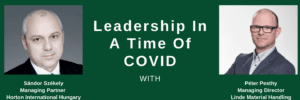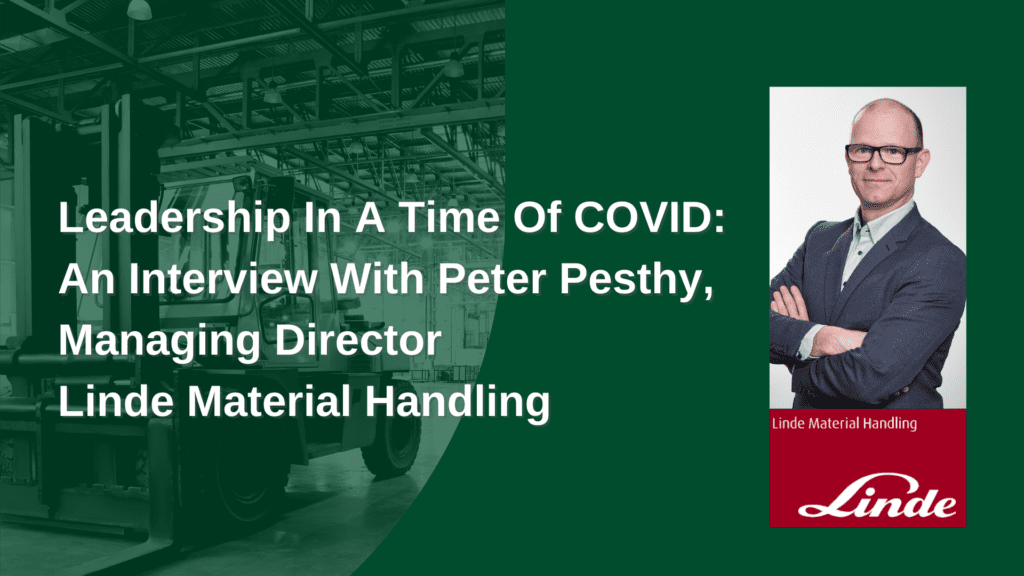Over the last year, every business has had to adapt in ways that we could never have imagined. Organisations in the manufacturing and logistics sectors have had to keep our supply chains moving despite enormous challenges.
We spoke to Peter Pesthy, Managing Director at Linde Material Handling, Hungary, about his professional journey through COVID-19.
Linde Material Handling is one of the world’s leading manufacturers of forklift trucks and warehouse equipment and is part of The KION Group, which are the world’s second-largest manufacturer of industrial trucks and one of the leading suppliers of automation solutions for intralogistics

Peter, can you tell us a little bit about Linde and how COVID has impacted your business?
At Linde, we provide forklift trucks, automation, racking systems and related services to any industry that needs to move or store anything. COVID heavily impacted the production and manufacturing industries, and yet we needed to keep going. So, we have made a substantial number of changes here.
Linde was among the first companies in Hungary to go into lockdown. It’s been 12 months, and we have had no single infected personnel at Linde Hungary. We have had some quarantined employees, but other than that, we managed to put strategies in place to keep everyone safe and keep the business moving.
Like most companies, we had to adapt how we work and how we communicated with our employees and our customers.
Also, our leadership team soon realised that we needed to re-plan our entire budget for 2020. It was a challenge, but we adjusted our costs and made it work!
How did you pivot the company during the COVID crisis to ensure profitability?
We formed the “Linde Crisis Team.” This team decided the critical actions needed for our field workers, office workers, and internal systems. Over two weeks, we transformed the whole company into a remote and digitised working environment.
During the first few weeks, employees were bringing their desktops and monitors home with them, trying to do their jobs, as usual, thankfully we utilised mobile solutions quickly! The whole thing was a tremendous change, a new way of working, mainly because anyway we were already undergoing a substantial organisational restructuring around the time COVID came.
One of our main revenue streams is the maintenance and servicing of material handling equipment. Our customers cannot run their businesses effectively if these machines aren’t working. So, we needed to rethink how to ensure that we took care of our customers in these new circumstances. On the back of this, we strengthened our field technicians’ training sessions, making sure they are even better prepared getting things done for those who rely on us. At the same time, we also generated additional revenue sources. For example, we introduced a new service to our customers: we would sanitise forklift trucks between shifts so that the truck driver who steps into the vehicle is in a disinfected environment.
We also knew that we needed to change how we communicated with both our customers and employees immediately. For our employees, we introduced a weekly Sunday message that I created, where I covered how we ere doing as a company, our cash situation, what our order situation was, and how we were doing for instance with recruitment of new colleagues.
For our customers, we kept in regular contact on social media channels and via direct mail and picked up the phone to see how they were. We quickly made sure to let our customers know that we were still there for them and that Linde was still running.
How did you respond personally and professionally to the crisis when it started?
After the initial shock, I looked at how we could manage our response. Together with the leadership team, we needed to think, “What is it that really makes this company sustainable?” and the end of the day, as cliched as it may sound, a company is about the sum of its people, both it’s customers and employees. So we made the people our focus.
In the beginning, it was challenging to find solutions to basic things such as acquiring masks from our suppliers. Our response was survival mode initially, but after three or four months, we realised that this is business-as-usual.
With our employees, we strengthened our development programmes to provide them with comfort and confidence. For example, the commercial career path programme initially planned for late 2021; we brought it forward to keep Linde’s commercial team engaged. It was essential also to keep all motivated. We tried to keep things going digital, while elevating interaction: we introduced new e-learning courses, virtual sport challenges and team competition, named “FittLinde” programme that was highly appreciated among all employees.
We have also managed to continue our Vision 2025 programme, which we are very proud of. It is a co-creation programme where we created our long-term vision and detailed plans together with employees. So our response has been to, again, focus on our two most essential asset groups: our customers and our employees, and trying to adapt to the digital way of working.
How did you approach marketing during this time?
We re-planned our marketing activities, both event and digital marketing. We introduced a new marketing approach, which, of course, is now only digital. We changed our customer contact; we introduced live chats and live meetings – which they seem got used to and like a lot.
Thanks to this, we have increased our order intake and increased our revenues while keeping our costs low. We didn’t achieve our original budget for 2020, but the whole business has ended up growing, so it was a real success story in the end.
What was your Human Resource strategy during COVID?
We have fortunately been able to increase our headcount rather than reduce the headcount. I’m proud to say that no single person left the company between February and December, in fact we ended up expanding our workforce!
We worked with few consulting partners on our HR strategy during this time, including very closely with Horton International on two particular projects.
Firstly, our management teams received competency-based recruitment training to have the capability and the knowledge to recruit online applying competency-based selection process. We also introduced online assessment centres, led and organised by Horton International, to find specialists in certain areas or mid-managers. Horton was extremely quick at implementing this compared to other companies we have worked with within the past. I was pleased with the speed and the quality of delivery.
The other area is the commercial career path and succession planning, which is an opportunity for the team to develop their skills and make sure that we select the right people, based on competency requirements, to rise through the ranks in the company.
It’s a brand-new programme, so we are yet to see the results completely, but we have the systems in place, and Horton has helped us to build this competency-based development program for our employees, which has been very well received
What would you consider your top three leadership challenges to have been during the pandemic?
I would say adaptability, how to continue the business and concentrate on the company’s newly set main focus points, and how you adapt to the whole situation.
Secondly, agility. How to keep serving our customers, who may have different requests, and how you respond to these customer demands. We also have to consider the long-term liabilities to our financing partners while accommodating our client’s payment needs.
Number three, which is something key for a leadership team, is confidence, the confidence that we still can make a success of the year, no matter how unusual the circumstances are.
Did you draw inspiration from other leaders during COVID-19?
It was great to read outlooks from some of the big analyst companies like BCG or McKinsey. That helped us when we were re-planning our financial figures for the year. We had an original budget when we started the year, and two months later, we needed to rethink everything. Those insights helped us in the way of thinking, “What could happen? Which industry segments could grow? Which industry segments might get into trouble?”
But honestly, the biggest inspiration I received was from our customers. I encouraged the leadership team and sales team to be in touch with our customers. We wanted to keep up the connection. We ended up sharing with other companies more than ever before, asking each other things like “How do you organise your shifts?” or “What do you use for sanitising in the office?” We started sharing basic stuff initially, and then as we have been progressing with the pandemic, other different questions. It’s become much more usual to collaborate in this way. This information from our customers was the best thing we could utilise.
What do you see happening in the future as a result of the COVID-19 pandemic?
Well, at the start of this pandemic last March, I would not have believed that we could make our way through in a way that allowed us to increase our revenues beyond those of 2019, but we did it, so I think that for the future anything is possible.
Our way of working is not going to be the same as it was pre-covid—for example, the utilisation of digital tools and the home office. I will support the hybrid home office and office combination moving forward. I think this is where the whole world is going, towards digitisation and finding good flexibility between working from home and on-site.
We are not an industry-dependent service provider, so we can go wherever there is a physical material movement. This year has taught how me that business can pivot according to what is going on across various industries, which we may not have thought of before. I think it taught us a lot about how to respond to an unplanned
I would be interested to see in a year’s time what the broader impact is, because it will be felt long-term. But I am an optimist, but if this year has taught us anything at Linde, it’s that we can think our way through any crisis and find a path to success. I am so grateful to everyone who pitched in to make it happen – We will be throwing a big party for our employees when it is safe!







